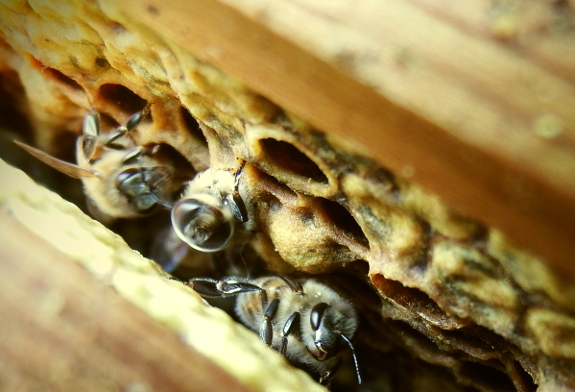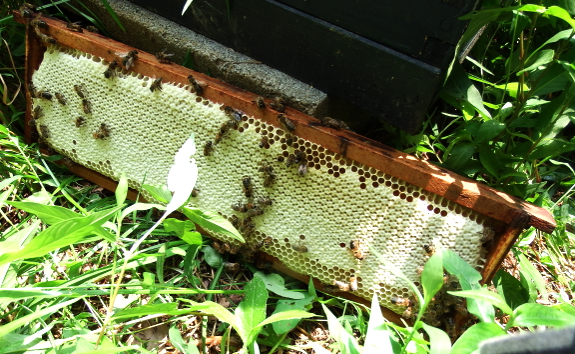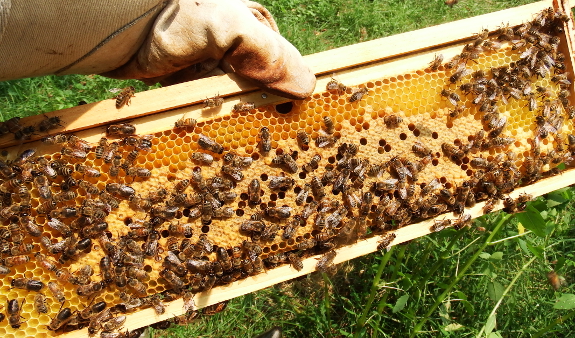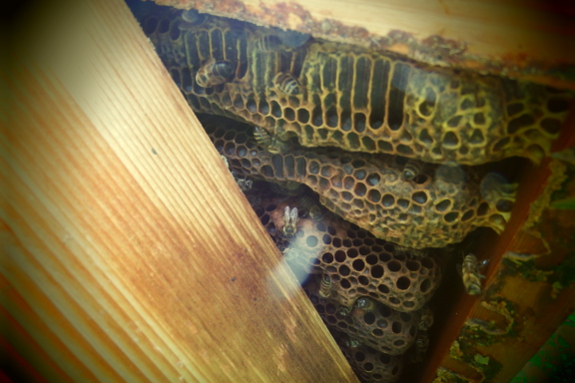
Checking for room in the hive during a nectar flow

Both the basswood and the
sourwood are blooming right now, so the hives are hopping. Which means
it's time to look inside and make sure there's enough space for the bees
to sock away all that honey.

You may recall that our mother hive has been weakened twice this year. First, I took a swarm-prevention split, then the hive swarmed anyway.
And yet, despite losing all of those workers (and me not finding a
second feeder to boost their stores with sugar water), there's quite a
bit of capped honey in the hive. The top box (a Warre box above a hive converter,
which was the original box in this hive) seems to be about half full of
honey and half full of capped brood. The next box down (a Langstroth
super) is similarly full. And the final box (another Langstroth super)
is full of drawn comb with some honey already stored therein.

I took the hive all the
way apart for two reasons. First, I was hoping to be able to take off
the Warre box and call the conversion a success. Unfortunately, there's
still brood in the Warre box, so I'll have to wait on finishing our
conversion.
My second reason was to
hunt for eggs, to see whether the newly hatched queen had begun to lay.
It's really too early to expect a virgin queen to have mated and started
to lay, though. And, sure enough, the only brood I found was capped
(some of which was hatching, like in the photo at the very top of this
post). So I'll have to wait there as well to see whether the new hive
has produced a successful queen.
However, I did use the
intrusion to good effect in the end. Since I had the hive entirely
dismantled, I took the opportunity to add another empty super, although I
put it at the very bottom in the Warre manner. Hopefully that will give
the bees room to continue drawing comb and socking away the massive
amounts of nectar that seem to be winging into the apiary this week.
After all, I can hear the bees flying from the back porch, about 150
feet away, so I know they're working hard!

Meanwhile, the daughter
hive (from an early June split) is much less populous, but seems to be
doing quite well nonetheless. The top box is very heavy with honey and
brood, while the bottom box is fully drawn but appears mostly empty.
It's much harder to delve into a Warre hive in search of queen signs,
but the presence of brood four weeks after the split suggests that there
is a queen present and hard at work doing what she does best ---
expanding the hive.
I put the daughter hive back together as-is and left the bees to their
colony chores. Except for sugar water for the daughter hive, the apiary
should take care of itself for a few weeks now.
Want more in-depth information? Browse through our books.
Or explore more posts by date or by subject.
About us: Anna Hess and Mark Hamilton spent over a decade living self-sufficiently in the mountains of Virginia before moving north to start over from scratch in the foothills of Ohio. They've experimented with permaculture, no-till gardening, trailersteading, home-based microbusinesses and much more, writing about their adventures in both blogs and books.
Want to be notified when new comments are posted on this page? Click on the RSS button after you add a comment to subscribe to the comment feed, or simply check the box beside "email replies to me" while writing your comment.

I read an interesting article about collecting honey in spring instead of fall in cooler climates. I know you have not gathered in several years because of various reasons. Have you considered this approach so you do not need to sugar feed over winter?
Hope to hear back soon!
Brittany --- That's actually been our approach so far. The trouble is...there's never extra honey in the spring! I'm starting to wonder whether the colony doesn't self regulate. If it goes into winter with more honey than it really needs, they keep more bees around longer instead of whittling down the colony to the bare minimum. So they eat all the excess honey anyway.
This year, if there's excess, we'll harvest in the fall. That wouldn't result in us feeding over the winter, though. Instead, when harvesting in the fall, the goal is to leave enough for the winter since it's very hard to successfully feed bees in cold weather.
Thanks so much for the quick reply on that! I am hoping to convince my mother up in Maryland on a large suburban lot to keep bees as well. I would love to, but I currently live in Austin Texas and everyone I know who has kept bees down here has had thier hive become Africanized and it has become very aggressive. We live in the city limits on a small lot (1/8th acre) surrounded by households with children so I am afraid that might be A lawsuit waiting to happen, especially if the kids got stung by several at once.
The neighbors already think I am crazy for growing so many fruit trees and having chickens. I love your chicken waterer by the way, ours is 4 years old and still going strong!!